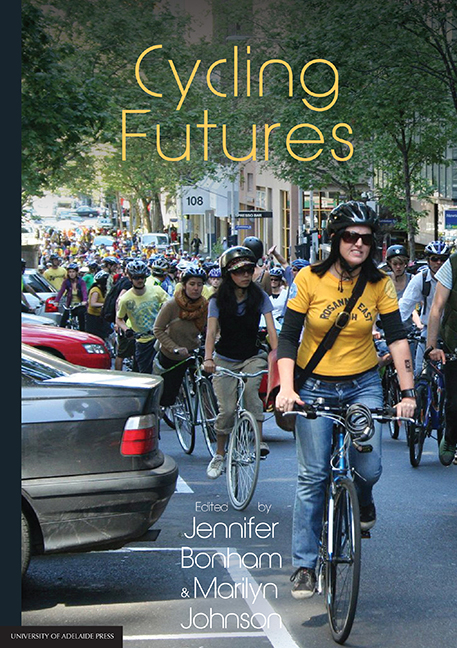Book contents
- Frontmatter
- Contents
- Preface
- Editors
- Contributors
- PART I Current challenges
- PART II Strategies for change
- 9 Gender and cycling: Gendering cycling subjects and forming bikes, practices and spaces as gendered objects
- 10 Making (up) the child cyclist: Bike Ed in South Australia
- 11 More than a message: Producing cyclists through public safety advertising campaigns
- 12 Spaces for cycling
- 13 Off-road cycling infrastructure
- 14 Teaching Australian civil engineers about cycling
- 15 What should planners know about cycling?
- 16 Skilling landscape architects and urban designers for design of bicycle parking and network facilities
- 17 Cycling and Australian law
13 - Off-road cycling infrastructure
from PART II - Strategies for change
Published online by Cambridge University Press: 25 July 2017
- Frontmatter
- Contents
- Preface
- Editors
- Contributors
- PART I Current challenges
- PART II Strategies for change
- 9 Gender and cycling: Gendering cycling subjects and forming bikes, practices and spaces as gendered objects
- 10 Making (up) the child cyclist: Bike Ed in South Australia
- 11 More than a message: Producing cyclists through public safety advertising campaigns
- 12 Spaces for cycling
- 13 Off-road cycling infrastructure
- 14 Teaching Australian civil engineers about cycling
- 15 What should planners know about cycling?
- 16 Skilling landscape architects and urban designers for design of bicycle parking and network facilities
- 17 Cycling and Australian law
Summary
Introduction
The previous chapter described the spaces for cycling with a focus on on-road facilities and safety issues, including the interface between off-road paths and the road. This chapter moves from the roadway to examine the types of off-road spaces for cycling; who uses them and why; and the influences of these spaces on both cycling participation and safety.
Disagreements abound in the literature regarding spaces for off-road riding. The first level of disagreement relates to what spaces should be included under the term ‘off-road’. In this chapter, a practical approach is taken, with off-road spaces encompassing all those which are beyond the roadside kerbs. Under this definition, bicycle lanes with painted (but not physical separators) are classified as on-road spaces, while footpaths (sidewalks in North America) are classified as off-road, whether they are specifically marked for bicycle use or not. In terms of the New Zealand lexicon of cycling facilities introduced in the previous chapter (Lieswyn et al., 2012), the off-road spaces considered in this chapter include:
1. cycle paths — whether Danish cycle tracks or cycle paths at footpath level, called cycle tracks in the European Cycling Lexicon (European Economic and Social Commission, 2011)
2. exclusive or shared paths (beside a road or in a park)
3. footpaths.
Trails (mountain bike [MTB] tracks and shared-use trails) belong to the general category of off-road spaces but are not discussed in this chapter because of the focus of this book on urban cycling.
Disagreements also exist regarding the role and function of on-road versus off-road spaces for cycling. Some cycling advocates argue that all roads should be made safe and convenient for cycling and that there should be no real need or advocacy for off-road spaces. In contrast, some road safety advocates propose that on-road cycling should be allowed in only very restricted circumstances. For example, in describing the Swedish Vision Zero road safety philosophy, Johansson (2009) states that vulnerable road users (cyclists and pedestrians) should be separated from motorised vehicles whose speeds exceed 30 km/h.
- Type
- Chapter
- Information
- Cycling Futures , pp. 283 - 302Publisher: The University of Adelaide PressPrint publication year: 2015



